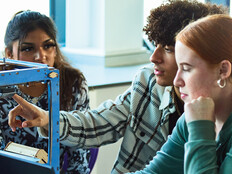The Do's and Don'ts of Project-Based Learning Technology Integration
Educators embracing project-based learning to engage students. In PBL, teachers create assignments rooted in the real world to help students build important skills such as problem-solving, communication and teamwork.
At McKissack Middle School in Nashville, Tenn., for example, educators turned another textbook history lesson into an interactive exploration of the story of their students’ home town, culminating in the development of a virtual museum.
“It allows students to answer that age-old question that they have always asked: Why do I need to know this?” said Jane Krauss, a co-author of Reinventing Project-Based Learning, Third Edition. “And that’s because what they’re doing and learning is more like the outside world that they’re going to enter — whether it’s college or career — and how they’ll interact within it, whether it’s problem-solving through collaboration and critical thinking or creating things or having opportunities to learn new technology skills.”
MORE FROM EDTECH: Check out these seven steps to create a project-based learning curriculum.
Best Practices to Select Digital Tools for PBL
Personalized learning and classroom technology go hand-in-hand. Through personal devices, multimedia software and other integrations, students have the tools they need to be creative problem solvers.
“It’s just good teaching and learning,” Thomas Chappelle, principal of McKissack Middle School, told EdTech. “We’ve found PBL combined with technology to be one of the best ways to engage students in their academics and expose them to different real-world topics.”
A few basic guidelines help teachers successfully integrate classroom technology into PBL:
Do:
- Plan and collaborate with others, including teachers, administrators and tech experts, to effectively tie the project to learning standards and ensure you’re using the best possible technology.
- Recognize that the best PBL is personalized, so make your inquiries open-ended and design the project so that students can find their own interests and style within it.
- Leverage technology tools that students already know how to use or want to learn — if they fit the project — as this will ramp up engagement.
Don’t:
- Choose a technology tool because it seems cool or you think it fancies up the project. Make sure it’s relevant and adds to the project.
- Feel like you have to plan every minute of the day in a scripted way or use technology during every phase of the project.
- Assume that students won’t be interested in engaging with a project that doesn’t involve technology.
To learn more about project-based learning, check out "Project-Based Learning Engages K–12 Students with Real-World Challenges."









